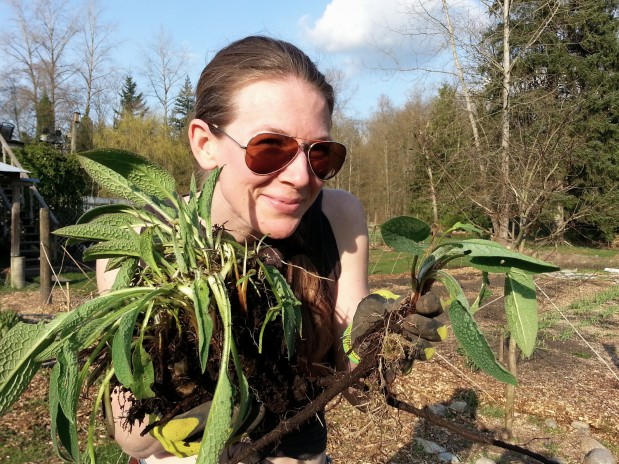I’m not going to pretend to be an expert on comfrey. Like everything garden-related, I still feel very ‘young’ in my knowledge of plants and ecological growing systems. I am, however, much more knowledgable now than I was a couple years ago, and one thing I know for certain is that I. LOVE. COMFREY.
I posted a photo of some comfrey on our facebook page recently and received some comments of concern about it being an invasive, hard-to-get-rid-of plant, so I thought I’d write a blog post about why comfrey is awesome, to set the record straight about how it grows, and to provide some tips on how to get rid of it if you don’t want it in your garden anymore.
Here’s what I do know: Comfrey is a perennial herb plant that produces large leaves, small bell-shaped flowers, and grows a long root. It grows well in damp grassy areas (most of ours grows along the drainage ditch on the northern side of our property). Comfrey is also a permaculture superplant! Here’s why:
- Medicinal qualities: comfrey is great at healing wounds. Comfrey root extract speeds recovery of bone injuries and a poultice of mashed comfrey leaves heals cuts and scrapes. (For external use only. The internet has a lot of information about how to safely use comfrey medicinally. Some people make comfrey tea, but others warn that ingesting comfrey can cause liver damage, so do your research carefully before considering any internal use of comfrey.)
- Beneficial insect magnet: Important pollinators like bees and other insects are very attracted to the pink and purple flowers that comfrey plants produce.
- Nutrient accumulator: comfrey is a power plant when it comes to providing nutrients for garden soil and compost systems. Comfrey roots dig deep below the surface of the soil (like 10 feet deep!) to places where other plant roots can’t reach. The roots pull potassium, calcium, and magnesium up to the comfrey leaves, which can then be cut off and added to compost bins or laid directly on soil as a rich mulching material. We practice the chop-and-drop technique: we plant comfrey at the base of each of our fruit and nut trees as well as near garden beds, and we ‘chop’ the leaves off as they get big and ‘drop’ them around the base of the trees or other plants. In addition to adding rich nutrients to the soil, the large mulch leaves shade the soil from sun and help maintain moisture in the top layers of soil so that they do not dry out quickly in the dry summer months.
- Underground soil-improver: comfrey’s deep tap roots can break up heavy clay soil, and when the leaves above-ground are chopped off, they result in some underground root dieback. The dying root stays in the ground, decomposing into helpful organic matter, nourishing the soil below the surface.
- Perennial: no need to re-plant this super plant every year. It will return year after year, regularly providing you, your soil, and your garden’s insects with its awesomeness.
- Easy to transplant: comfrey is also super-easy to transplant. For the past month, I’ve been cutting chunks of root and leaves from our larger comfrey plants and transplanting the cuttings to other areas of the gardens where I know it will be helpful to have it.
Warnings about comfrey:
- Comfrey is not invasive, but… Comfrey is not an invasive plant. It does not send out runners or vines to take over garden beds or lawns like our morning glory and buttercup does. Most varieties of comfrey also do not set seed (including the comfrey we have growing on our property). HOWEVER, comfrey root grows very successfully after being divided (which is why it’s so easy to transplant), SO if you have comfrey on your property and you want to get rid of it, DO NOT try to dig it out or rototill near it. If even a tiny piece of root breaks off and is left in the ground, it will re-grow. The best way to get rid of comfrey is to sheet mulch over it. It will not send out shoots or runners to get around the mulch. Just lay some cardboard and other mulching materials on top of it to rob it of sunlight and you’ll be all set.
Most of what I know (and have shared) about comfrey, I have gotten from permaculturalists and permaculture books. Toby Hemenway’s ‘Gaia’s Garden’ has a lot of great information about comfrey (and is our favorite permaculture book in general, so lots of good reasons to check it out :).
Comfrey really is awesome. Like I said above, I love it. I love that transplanting it is so easy, that it attracts pollinators that our fruit trees, squash, and tomato plants need, and that I can depend on it to enrich our soil and to provide an easy to use (and fast to re-grow!) mulch material. After using comfrey in our gardens here, I can’t imagine ever having a garden without it.
For anyone interested in getting their hands on some comfrey for their own garden, we will be selling pots of it at the upcoming Earth Day Farmers Market in Maple Ridge (April 20th, 10am-2pm, Memorial Peace Park on 224th).
UPDATE: This seems to be the most popular blog post on our site. I’m glad that folks find it useful but I’m sad to say that we cannot assist in requests for comfrey anymore since Jocelyn and Chris K. have moved to Nova Scotia. Maybe once our new business, Seven Acres Farm, is underway we will be able to mail root cuttings around the country. – Chris K., 2015/04/06
